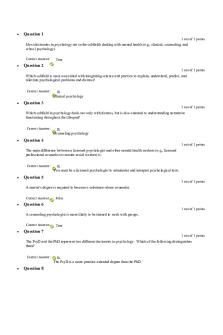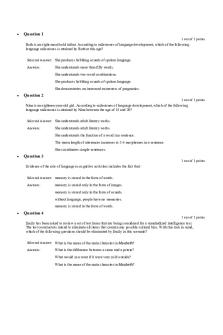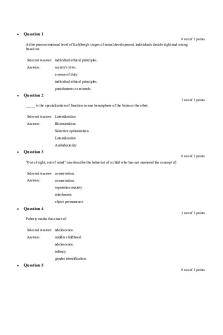Weekly Quiz Answers PDF

| Title | Weekly Quiz Answers |
|---|---|
| Course | Investment Analysis |
| Institution | University of Western Australia |
| Pages | 4 |
| File Size | 63.8 KB |
| File Type | |
| Total Downloads | 21 |
| Total Views | 144 |
Summary
Download Weekly Quiz Answers PDF
Description
Week 1 1. The kind of work that Jyoti, a wandering cash deposit collector, does in india is an example of “qualitative asset transformation”. TRUE 2. A farmer enters a contract to sell her product at a fixed price in the future and the future market price turns out to be five times as high as the agreed fixed price. This is an example of inefficient risk sharing. FALSE 3. MoneyMe is a new financial technology (“fintech”) firm that lends up to $2,000 at monthly interest rates of between 15 and 24 per cent (i.e., between 59 and 68 per cent annualized). The major banks charge annual interest rates of around 14% for purchases on credit card and 22% for cash advances on credit card. The most likely implication is: MoneyMe is more efficient than the major banks in servicing high-risk short term borrowers 4. Based on information in this lecture, which of the following statements is most accurate: Deregulation of finance increases the expansion of credit. 5. Based on information in this lecture, which of the following statements is least accurate: Finance has always paid more than other industries Week 2 1. Interest rates close to zero on government bonds indicate investors are risk averse TRUE 2. Interest rates close to zero on government bonds imply that governments can borrow money cheaply TRUE 3. A rural economy has a cattle market. Every March the cattle have a very small chance of catching “mad cow” disease. In most years, no cow gets “mad cow disease”. If a cow does get diseased, it happens early rather than later in March. Is the typical monthly return to holding livestock in March likely to be higher or lower than in other months? HIGHER 4. An increase in discount rate from one percent to two percent has a more significant impact on value than increase from 10% to 16% TRUE 5. Changes in E( R ) are mostly driven by market sentiment TRUE Week 3 1. “Stocks are a cheaper source of capital for corporations because they don’t require fixed-interest payments” FALSE 2. If you expect the yield curve to flatten, you should sell bonds with longer maturities to capture the capital gain. FALSE (Interest rates are going down, Price goes up)
3. A portfolio consisting solely of bonds with a yield of 5% or less can have a return greater than 5% TRUE 4. Nobel Prizing economist Milton Friedman stated: “a zero interest rate policy is evidence of an extremely tight monetary policy” TRUE 5. Many financial experts like Jeremy Siegel recommended stocks in the long run because equities are less volatile than bonds FALSE Week 4 1. The equity risk premium is, at least in theory, constant over different periods. FALSE 2. Under the CAPM, if a $10 million dollar mining company has a lower beta than BHP Billiton its discount rate will be lower than the rate for BHP Billiton (the world’s largest miner) TRUE 3. The CAPM is widely used in industry TRUE 4. The CAPM performs less well than several models in predicting expected returns TRUE 5. If US hedge funds always underperformed the S&P500 index that would be a sign of an inefficient market TRUE (expect to sometimes over perform and sometimes underperform, if an asset class continues to underperform the prices will go down and returns will go up) Week 6 1. A noise investor will not suffer poorer performance in an efficient market. TRUE (Random, diversify therefore wont necessarily lose) 2. 19 October 1987, “Black Monday”, was the start of the 1987 stock market crash when stock markets around the world lost considerable value over a short period of time. By the end of October 1987, the ASX had fallen 41.8%. Prices do not fall by such a large percentage in an efficient market. FALSE (E.g. fall in iron ore prices, no obvious explanation for the crash -> unusual) 3. It is not possible to achieve a higher return than the market portfolio in an efficient market FALSE (Taking greater risk) 4. “Sydney as a whole has grown by an average of 6.83% each year for the past 10 years, according to Residex in December last year”. Other things being equal, an increase in houses price with no change in expected rental growth indicates lower future returns to housing. TRUE (Higher prices -> Lower returns) 5. If a market is inefficient then it is relatively straightforward to exploit inefficiency to earn above normal risk-adjusted returns. FALSE
Week 7 1. A company under-performing in profitability relative to other companies could be a good investment TRUE 2. Quantitative easing reduces the impact of the “liquidity trap” FALSE 3. High iron ore prices are a barrier to entry for potential entrants to iron ore producers FALSE 4. Other things being equal, a high level of competition amongst firms is bad for economic growth and bad for profits. FALSE 5. Given that oil is a finite natural resource, oil prices will increase in future and so investing in oil companies today will offer high returns in future. FALSE Week 8 1. A “liquidity crisis” can be resolved if lenders are willing to wait long enough for borrowers to sell their assets and obtain cash to repay their debts. TRUE 2. To facilitate economic activity and stability, the optimal level of government debt is zero. FALSE (without government debt there wont be risk-free securities) 3. Hyman Minsky defined “hedge borrowers” as those who can repay interest and principal from investment cash flows and “speculative borrowers” as those who can repay interest only from investment cash flows. “Speculative borrowers” have higher expected return. TRUE 4. History shows high levels of government debt are closely associated with high interest rates. FALSE (Japanese government high level of debt, negative interest rates) 5. The availability of subprime borrowers to get access to capital at high interest rates is consistent with an efficient market. TRUE Week 9 1. Real Options theory proves that “bubbles” don’t exist FALSE 2. Uncertainty over the size of a potential discovery increases the value of a mining exploration company TRUE 3. The more uncertain the outcomes of a building project the greater the value of the project FALSE 4. Real options cannot be valued by discounting cash flows so rational investors should not pay cash for them FALSE
5. A real option is more valuable if you have exclusive rights to to use exercise the option imbedded in it (and also the right to sell the option) TRUE Week 11 1. A company using a zero-cost collar to hedge its revenue will lower its beta TRUE (Reducing the amount prices move with the market) 2. Winning the lottery is an example of a “Black Swan” event FALSE (Predictable) 3. The cost to companies of holding cash is higher when interest rates are higher TRUE (Opportunity of cash, investing) 4. Other things being equal, diversified investors prefer companies that have forward sold their production and locked in the gain FALSE 5. To protect against a fall in revenue, a company can sell a put option and pay for it by using the proceeds from a call option FALSE (Buy a put option) Week 12 1. Risk averse investors should not invest in the stock market if they wish to lower their portfolio’s risk. FALSE 2. Grossman & Stiglitz’s argument about the impossibility of informationally efficient markets proves that passive investing is not optimal. TRUE 3. Time-weighted returns – where returns are not weighted by investment amount – is best for evaluating a managers’ market timing ability. TRUE 4. Suppose two portfolios have the same average return, the same standard deviation of returns, but portfolio A has higher beta than portfolio B. According to the Treynor measure, the performance of portfolio A is poorer than the performance of portfolio B 5. Suppose two portfolios have the same average return, the same standard deviation of returns, but Aggie Fund has a higher beta than Raider Fund. According to the Sharpe measure, the performance of Aggie Fund is the same as the performance of Raider Fund...
Similar Free PDFs

AP quiz+answers - Weekly quiz
- 1 Pages

Weekly Quiz Answers
- 4 Pages

weekly Module Quiz answers
- 5 Pages

COMMGMT 1001 - weekly quiz answers
- 24 Pages

QUIZ 2 - Weekly Quiz
- 2 Pages

Quiz 8 - Weekly Quiz
- 6 Pages

Quiz 3 - Weekly Quiz
- 6 Pages

Quiz 5 - Weekly Quiz
- 6 Pages

Quiz 10 - Weekly Quiz
- 6 Pages

Quiz 2 - Weekly Quiz
- 6 Pages

Quiz 9 - Weekly Quiz
- 6 Pages

Chapter 12 Quiz - Weekly Quiz
- 3 Pages

Chapter 8 Quiz - Weekly Quiz
- 3 Pages

Weekly Quiz 1 Solutions
- 3 Pages

Titas Weekly Quiz 5
- 2 Pages
Popular Institutions
- Tinajero National High School - Annex
- Politeknik Caltex Riau
- Yokohama City University
- SGT University
- University of Al-Qadisiyah
- Divine Word College of Vigan
- Techniek College Rotterdam
- Universidade de Santiago
- Universiti Teknologi MARA Cawangan Johor Kampus Pasir Gudang
- Poltekkes Kemenkes Yogyakarta
- Baguio City National High School
- Colegio san marcos
- preparatoria uno
- Centro de Bachillerato Tecnológico Industrial y de Servicios No. 107
- Dalian Maritime University
- Quang Trung Secondary School
- Colegio Tecnológico en Informática
- Corporación Regional de Educación Superior
- Grupo CEDVA
- Dar Al Uloom University
- Centro de Estudios Preuniversitarios de la Universidad Nacional de Ingeniería
- 上智大学
- Aakash International School, Nuna Majara
- San Felipe Neri Catholic School
- Kang Chiao International School - New Taipei City
- Misamis Occidental National High School
- Institución Educativa Escuela Normal Juan Ladrilleros
- Kolehiyo ng Pantukan
- Batanes State College
- Instituto Continental
- Sekolah Menengah Kejuruan Kesehatan Kaltara (Tarakan)
- Colegio de La Inmaculada Concepcion - Cebu
